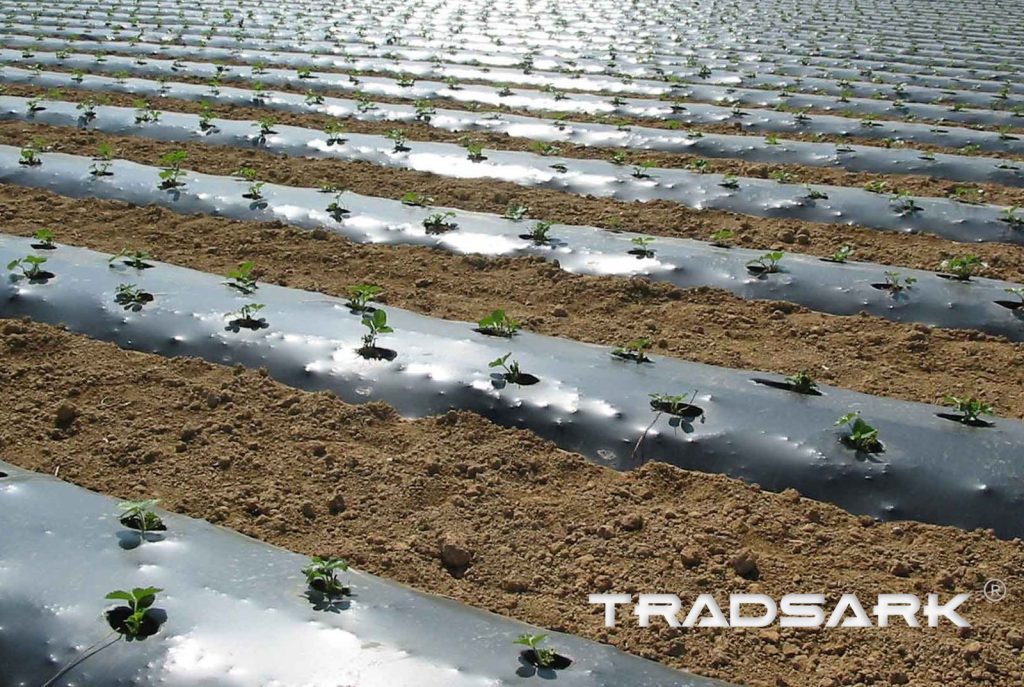In modern agricultural greenhouse cultivation, black agricultural mulch film has become a key material for improving planting efficiency due to its unique functional properties. As a professional supplier of agricultural films, Tradsark’s black agricultural mulch film, with its stable performance and wide applicability, provides efficient solutions for various greenhouse crop cultivation.
Core Advantages of Black Agricultural Mulch Film
Precise Temperature Increase, Promoting Early Growth of Spring-Sown Crops
Tradsark’s black agricultural mulch film has a sunlight absorption rate of over 90%, which can quickly conduct the absorbed heat to the soil surface, increasing the 耕作层 temperature by about 2.8℃. This feature is particularly important for spring greenhouse planting—in the seedling stage of spring-sown crops such as tomatoes, cucumbers, and peppers, it can shorten the germination time by 3-5 days, promote early root development, and lay a foundation for high yields in the later stage. Even in cold weather such as late spring cold snaps, it can reduce soil heat loss and avoid seedling frost damage.
Weed Control and Soil Protection, Reducing Field Management Costs
Black mulch film completely blocks light penetration, causing weeds under the film to wither naturally due to inability to perform photosynthesis, with a weed control efficiency of over 90%. For malignant weeds common in greenhouses, such as crabgrass and goosegrass, there is no need for frequent herbicide use or manual weeding, which not only reduces labor input but also decreases pesticide pollution to soil and crops. At the same time, the film fits tightly to the ground, which can reduce soil compaction caused by rain erosion, keep the 耕作层 loose and breathable, and facilitate root respiration.
Practical Effects on Improving Crop Yield and Quality
Years of field application data show that greenhouse cultivation using Tradsark black agricultural mulch film has significantly improved yield and quality:
- Fruits and vegetables: In watermelon cultivation, covering with black film can increase single fruit weight by 0.5-1 kg, sugar content by 1-2 degrees, and advance maturity by 7-10 days; in eggplant cultivation, fruit coloring uniformity is improved by 30%, and the rate of malformed fruits is reduced to below 5%.
- Root and tuber crops: For underground fruiting crops such as potatoes and radishes, black film can maintain stable soil temperature and humidity, reduce skin damage and pest infestation, and the rate of commercial fruits is increased to over 95%.
- Leafy vegetables: In the cultivation of fast-growing leafy vegetables such as lettuce and spinach, the mulch can reduce soil contamination on leaves, keep the plant type neat, and reduce the incidence of diseases such as downy mildew, extending the harvest period by 15-20 days.
Technical Characteristics of Tradsark Black Agricultural Mulch Film
- Durability: Made of high-strength polyethylene raw materials with added anti-ultraviolet additives, it has a service life of 3-5 years in greenhouse environments, with excellent tear resistance and puncture resistance, and can withstand mechanical stress from agricultural machinery operation and crop growth.
- Flexible specifications: Available in various widths from 0.8m to 4m and thicknesses from 1.0 to 2.0 mils, which can be customized according to greenhouse ridge width and crop row spacing to reduce splicing waste; roll lengths support 500m-2000m to meet different planting scale needs.
- Environmental compatibility: In addition to conventional black films, degradable black mulch films are also available, which naturally degrade into harmless substances within 6-12 months after crop harvest, suitable for organic agriculture and ecological planting models, contributing to sustainable development.
Scientific Laying and Usage Skills
- Preliminary preparation: Greenhouse soil needs to be deeply plowed and raked to remove debris such as stones and residual roots to ensure the ground is flat; ridges are made according to crop row spacing, with a ridge height of 15-20 cm to facilitate film fitting.
- Laying method: Spread the black film flat on the ridge surface, compact both sides with soil, and keep the film tension moderate (too tight is easy to tear due to thermal expansion and contraction, too loose is easy to be blown up by the wind); punch holes at the crop planting positions, with a hole diameter slightly larger than the seedling root system to avoid damaging the plants.
- Supporting management: It is recommended to use with a drip irrigation system, laying the drip tape under the film, which can not only accurately replenish water but also reduce water evaporation and condensation on the film surface; regularly check the integrity of the film, and repair damage with special tape in time to prevent weeds from growing from the breaks.
Why Choose Tradsark Black Agricultural Mulch Film?
Tradsark has been deeply involved in the agricultural film industry for many years, always focusing on the needs of growers:
- The products have passed national agricultural film quality inspection, with indicators such as heavy metals and odors meeting food safety standards, and can directly contact various edible crops;
- Provide one-stop services of “film + laying tools + technical guidance”, and recommend suitable products according to different regional climates (such as low temperature in the north, high humidity in the south);
- Support small-batch trial purchase and customized production to meet the needs of family farms, large-scale planting bases and other different scales.
Whether it is early spring seedling raising, summer cultivation or autumn and winter production preservation, Tradsark black agricultural mulch film can create an ideal growth environment for greenhouse crops through the multiple effects of temperature control, weed control and soil protection, turning every bit of planting input into real benefits.


